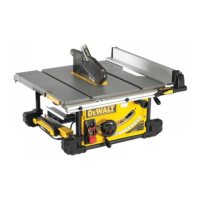15
ENGLISH
WARNING: Do not touch the saw blade after working
before it has cooled. The saw blade becomes very hot
whileworking.
NOTE: This tool has blade installed fromfactory.
1. Raise the saw blade arbor to its maximum height by turning
the blade height adjustment wheel
6
clockwise.
2. Remove the throat plate
16
. Refer to Mounting the
ThroatPlate.
3. Using wrenches
20
, loosen and remove the arbor
nut
22
and flange
24
from the saw arbor by turning
anti-clockwise.
4. Place the saw blade on to the spindle
23
making sure the
teeth of the blade
2
point down at the front of the table.
Assemble the washers and arbor nut to the spindle and
tighten arbor nut
22
as far as possible by hand, making sure
that the saw blade is against the inner washer and the outer
flange
24
is against the blade. Ensure the largest diameter
of the flange is against the blade. Ensure the spindle and
washers are free from dust anddebris.
5. To keep the spindle from rotating when tightening the
arbor nut, use the open end of the blade wrench
20
to
secure thespindle.
6. Using the arbor wrench, tighten the arbor nut
22
by
turning itclockwise.
7. Replace the throatplate.
WARNING: Always check the rip fence pointer and the
blade guard assembly after having changed theblade.
Mounting the Blade Guard Assembly/
Riving Knife (Fig. A, D)
WARNING: Use the guard assembly for all
throughcutting.
WARNING: Use the riving knife for non-through-cutting
when blade guard assembly cannot beused.
WARNING: Do not insert both the blade guard assembly
and the non-through-cutting riving knife into the clamp
at the same time.
NOTE: The saw is shipped with the non-through-cutting riving
knifeinstalled.
1. Raise the saw blade arbor to its maximumheight.
2. Install blade guard assembly by pulling the guard release
lever
12
and inserting either the non-through-cutting
riving knife
52
or the blade guard assembly
11
until it
bottomsout.
3. Release lever, make sure clamp plates are fully closed and
clamp the splittersecurely.
WARNING: Before connecting the table saw to the power
source or operating the saw, always inspect the blade
guard assembly for proper alignment and clearance
with saw blade. Check alignment after each change of
bevelangle.
WARNING: To reduce the risk of serious personal injury,
DO NOT operate saw if blade assembly is not securely
clamped inplace.
When properly aligned, the splitter
13
or riving knife
52
will
be in line with the blade at both table top level, and at the top
of the blade. Using a straight edge, ensure that the blade
2
is
aligned with the splitter
13
or riving knife
52
. With power
disconnected, operate the blade tilt and height adjustments
through the extremes of travel and insure the blade guard
assembly clears the blade in alloperations. Refer to Aligning
Guard Assembly/Splitter to Blade.
WARNING: Correct mounting and alignment of the blade
guard assembly is essential to safe operation!
To Remove the Blade Guard Assembly/
Riving Knife (Fig.D)
1. Pull the guard release lever
12
.
2. Lift up on blade guard assembly
11
or riving knife
52
.
Mounting the Anti-Kickback Assembly
(Fig. E)
WARNING: To reduce the risk of serious personal injury,
the anti-kickback assembly must be in place for all
possible cuts.
1. Remove the anti-kickback assembly
53
from the storage
position. Refer to Storage.
2. Locate the anti-kickback mounting slot
55
at the top of the
splitter
13
.
3. Align the stem
54
with the mounting slot. Depress the
stem and push down on the anti-kickback assembly
53
until it snaps and locks into place.
NOTE: Pull on the anti-kickback assembly to ensure it has
locked into place.
4. To remove the anti-kickback assembly, depress the stem
and pull up and out of the mounting slot.
With power disconnected, operate the blade tilt and height
adjustments through the extremes of travel and ensure the
blade guard assembly clears the blade in all operations and
that the antikickback assembly is functioning.
Mounting the Throat Plate (Fig. F)
1. Align the throat plate
16
as shown in FigureE, and insert
the tabs on the back of the throat plate into the holes on the
back of the tableopening.
2. Rotate cam counterclockwise until the front of throat
plate drops into place. Secure by rotating cam lock knob
40 clockwise 1/4 turn (when cam lock is under the table
holding the throat plate in place).
3. The throat plate includes four adjustment screws
25
which
raise or lower the throat plate. When properly adjusted, the
front of the throat plate should be flush or slightly below the
surface of the table top and secured in place. The rear of the
throat plate should be flush or slightly above the tabletop.
WARNING: Never use the machine without the throat
plate. Immediately replace the throat plate when worn
ordamaged.

